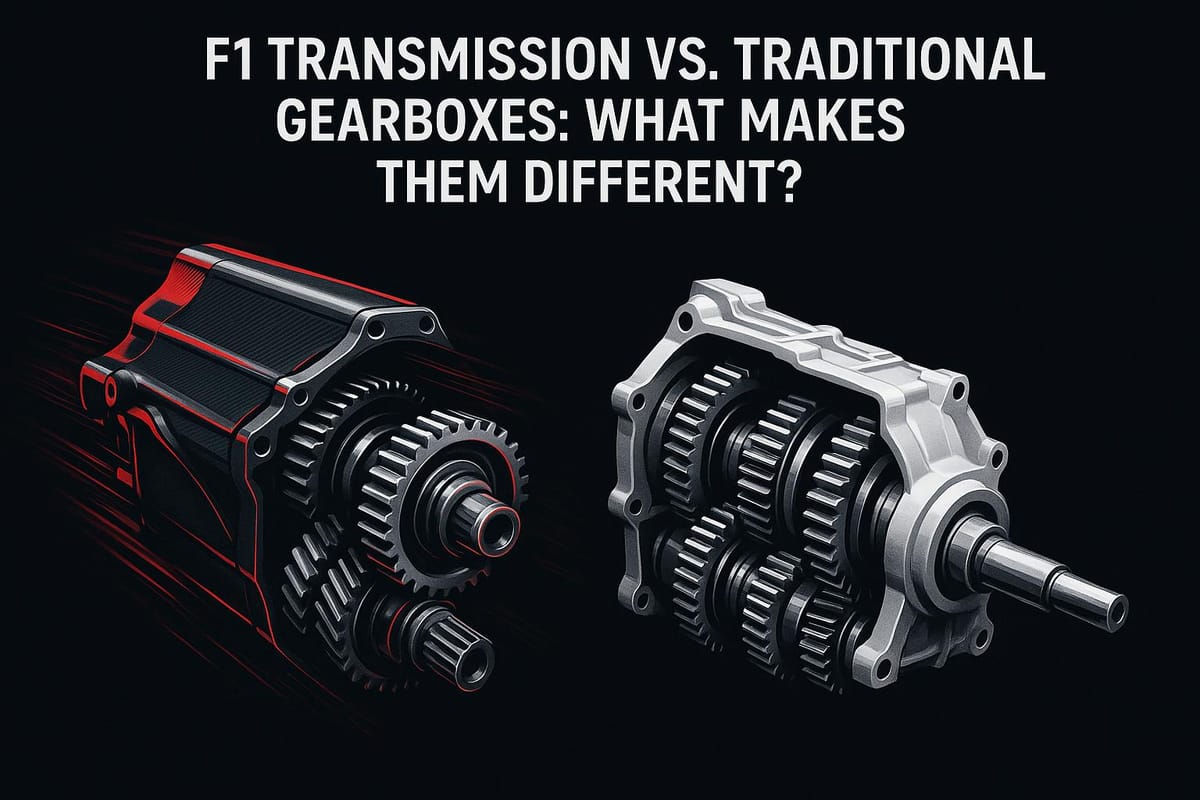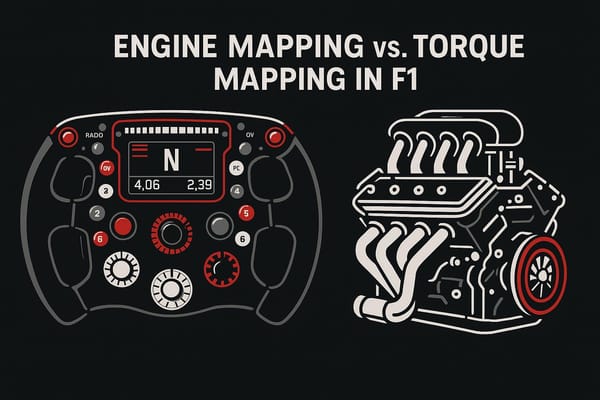F1 Transmission vs. Traditional Gearboxes: What Makes Them Different?
Explore the stark differences between F1 transmissions and traditional gearboxes in terms of speed, materials, and performance.

F1 transmissions are built for speed and precision, while consumer gearboxes prioritize durability and ease of use.
F1 gearboxes use advanced materials, sequential shifting, and lightning-fast gear changes to handle the extreme demands of racing. Consumer gearboxes, on the other hand, focus on comfort, affordability, and long-term reliability.
Key differences include:
- Shift Speed: F1 gearboxes shift in 2–4 milliseconds, compared to 100–500 milliseconds for consumer vehicles.
- Materials: F1 uses titanium and carbon fiber; consumer gearboxes use steel and aluminum.
- Cost: F1 gearboxes cost ~$320,000, while consumer versions range from $1,000–$5,000.
- Durability: F1 gearboxes last ~3,000 miles; consumer ones can last decades.
Quick Comparison
| Feature | F1 Transmissions | Consumer Gearboxes |
|---|---|---|
| Shift Speed | 2–4 milliseconds | 100–500 milliseconds |
| Materials | Titanium, carbon fiber | Steel, aluminum |
| Cost | ~$320,000 | $1,000–$5,000 |
| Durability | ~3,000 miles | Decades |
| Design | Sequential, paddle shifters | Manual/automatic |
F1 technology has influenced consumer cars, introducing features like paddle shifters, electronic gear control, and lightweight materials. However, the two remain vastly different in purpose and performance.
How to Build an F1 Gearbox (and How it Shifts) | F1 Engineering
F1 Transmission Technology
F1 transmissions operate under extreme conditions, handling immense stresses while delivering unmatched levels of power transfer, speed, and precision. These systems are engineered to perform at standards far beyond those of regular vehicles.
One standout feature of F1 transmissions is their sequential shifting system, which plays a key role in maximizing performance during races.
Semi-Automatic Sequential Systems
Formula 1 cars rely on semi-automatic sequential transmissions. Unlike traditional manual gearboxes that require a clutch pedal and an H-pattern shift, F1 cars use paddle shifters mounted behind the steering wheel. This setup allows drivers to change gears with a simple pull of a paddle, keeping both hands firmly on the wheel at all times.
Sequential shifting means gears can only be changed one step at a time, which ensures precise and rapid gear transitions. These systems also automate clutch and gear selection, enabling drivers to focus on timing their shifts perfectly - whether they’re overtaking a rival or defending their position on the track.
Instant Shift Technology
Taking sequential systems a step further, F1 transmissions incorporate seamless shift technology, enabling gear changes in just 2–4 milliseconds. For comparison, consumer vehicles typically achieve shifts in 100–500 milliseconds. This lightning-fast performance is made possible by a dual-barrel selector system: one barrel engages the current gear while the other pre-selects the next. When the driver initiates a shift, the transition happens without any interruption in power delivery.
This uninterrupted flow of power not only maximizes acceleration but can also shave off valuable tenths of a second per lap - an advantage that could be the difference between winning and losing. However, the system’s complexity means a failure in the dual selectors could result in catastrophic gear lockup.
Construction Materials and Strength
F1 transmissions are built using lightweight yet incredibly strong materials such as titanium, carbon fiber, and advanced alloys. These materials allow the gearboxes to withstand extreme stress and heat while keeping weight to a minimum, a critical factor in Formula 1 performance.
The use of such high-tech materials doesn’t come cheap. A modern F1 gearbox costs approximately $320,000, a stark contrast to the $1,000 to $5,000 price range of consumer car transmissions. In addition to their durable construction, F1 gearboxes integrate hydraulic, differential, and electronic systems to optimize power transfer, lubrication, and temperature management. Unlike the dual-clutch systems found in some road cars, which prioritize smooth gear changes, F1’s single-clutch design focuses entirely on speed, weight reduction, and efficiency.
How Consumer Vehicle Gearboxes Operate
Consumer vehicle gearboxes are built with durability and minimal upkeep in mind. They rely on a clutch to temporarily interrupt torque, ensuring smooth gear changes. This approach is a stark contrast to the high-speed, precision-focused transmissions found in Formula 1 vehicles.
Manual Transmission Systems
Manual transmissions offer a direct connection between the driver and the vehicle. Here, the driver takes full control, using a gear stick and clutch pedal to manage power delivery and gear ratios. When shifting gears, the clutch disengages the engine's power, allowing a gear change before re-engaging to resume power transfer.
To make these shifts smoother and reduce wear, synchronizers are used to match gear speeds. On the other hand, Formula 1 transmissions often use dog ring systems, which enable much quicker, though more abrupt, gear changes. While manual systems demand driver involvement, automatic transmissions handle gear changes independently for a more seamless experience.
Automatic Transmission Systems
Automatic transmissions take the responsibility of gear selection away from the driver. These systems use torque converters and planetary gear sets to automatically adjust gears based on speed, load, and driving conditions. Unlike the instantaneous shifts seen in Formula 1, automatic systems prioritize comfort and ease of use.
The design of automatic transmissions incorporates hydraulic mechanisms and torque converters to manage power interruptions smoothly. While consumer gearboxes often use synchromesh technology for gentle transitions, Formula 1 systems favor dog ring setups for their speed and efficiency, even if they are less forgiving.
Driver Control Requirements
Manual transmissions require skillful gear selection and precise clutch timing. This hands-on process demands careful technique, especially in stop-and-go traffic or challenging driving environments.
Proper clutch care is critical for extending the life of a manual transmission. Avoiding habits like riding the clutch pedal and using smooth, deliberate movements during engagement and disengagement can significantly reduce wear. In contrast, Formula 1 drivers rely on highly automated systems, where pulling a paddle shifter activates a complex series of electronic and mechanical processes.
Durability is another area where consumer and Formula 1 gearboxes diverge. Consumer transmissions are designed to last for decades with minimal maintenance, while Formula 1 transmissions often require frequent overhauls and may not survive even a quarter of a racing season. Materials further highlight the difference: consumer gearboxes are typically made from steel, iron, and aluminum, while Formula 1 relies on lightweight yet strong materials like titanium and magnesium to handle extreme conditions.
Manual transmissions also tend to provide better fuel efficiency due to their direct mechanical link between the engine and wheels. However, this efficiency often comes at the cost of convenience, which has led most American drivers to favor automatic transmissions for everyday use.
Performance Comparison: F1 vs Consumer Gearboxes
F1 and consumer gearboxes are worlds apart in terms of speed, efficiency, and design. Each is crafted to meet very different demands, reflecting the priorities of motorsport versus everyday driving.
Shift Speed and Power Transfer
When it comes to speed, F1 gearboxes are in a league of their own. They can shift gears in just 2–4 milliseconds, a necessity when drivers make over 3,800 gear changes during a typical 2-hour Grand Prix at speeds averaging 186 mph. Compare this to consumer vehicles, where even high-performance automatic transmissions take hundreds of milliseconds to shift, while standard systems can take several seconds to complete the process of clutch disengagement, gear selection, and re-engagement.
Efficiency is another key difference. F1 transmissions boast about 98% efficiency from input to output, thanks to their precision engineering and dry sump lubrication systems, which significantly reduce friction and windage losses. For example, spur gears in F1 systems lose only about 0.30% of energy to gear mesh friction, while bevel gears lose around 0.50%. On the other hand, consumer automatic transmissions are less efficient. Losses stem from components like torque converters, hydraulic pumps, and the design of epicyclic gear trains, which involve two mesh contacts compared to the single contact in F1’s spur gear systems. The relentless push for speed and efficiency in F1 explains the intricate and costly engineering behind these systems.
Design Complexity and Manufacturing Cost
F1 gearboxes are marvels of engineering, but they come at a steep price. Building a single F1 gearbox can cost upwards of £250,000 (approximately $312,500). These costs reflect the use of advanced materials and cutting-edge manufacturing techniques like 3D printing, which allow for structural integration that consumer gearboxes simply don’t require. For instance, F1 gearboxes are designed as stressed members, meaning they contribute to the car’s structural integrity. In contrast, consumer gearboxes are bolted onto the chassis and don’t play a structural role.
Consumer gearboxes, by comparison, are far less expensive to produce. They rely on more traditional materials like steel and aluminum and are manufactured using conventional casting and machining processes. The focus here is on affordability and reliability for the average driver, rather than the extreme performance demands of motorsport.
Stress Tolerance and Lifespan
The stress levels these gearboxes endure further highlight their differences. F1 transmissions are built to handle extreme, instantaneous loads during races, including torque spikes and rapid acceleration that would overwhelm a consumer gearbox. In contrast, consumer systems are designed for long-term durability, capable of performing reliably over years of regular use.
Even the reverse gear design underscores the disparity. F1 gearboxes use lightweight, thin reverse gears, as they’re only needed briefly, such as for pit lane maneuvers. Consumer gearboxes, however, require more robust reverse gears to handle frequent and varied use.
Maintenance and operating conditions also set these systems apart. F1 gearboxes are meticulously maintained under controlled conditions, with constant monitoring to ensure peak performance. Consumer gearboxes, on the other hand, are built to operate reliably across a wide range of temperatures and driving conditions, with routine maintenance performed far less frequently.
F1 Technology Influence on Consumer Cars
Formula 1's relentless push for speed and precision has left a lasting mark on the automotive world. Many of the cutting-edge innovations tested on the track have found their way into everyday vehicles, shaping how we experience performance, control, and efficiency on the road.
Paddle Shifter Integration
Ferrari introduced paddle shifters to Formula 1 in 1989, revolutionizing how drivers controlled gear changes. That same year, Nigel Mansell secured a win at the Brazilian Grand Prix using an electrohydraulic gearshift system. By 1995, this technology had become a standard feature in F1 cars. Fast forward to 1997, and Ferrari brought this innovation to the consumer market with the F355 F1 Berlinetta, the first road car to feature paddle shifters. This allowed drivers to execute faster, more seamless gear changes .
Emanuele Carando, Ferrari’s head of global marketing, highlighted the impact of this technology:
"Its electrohydraulic system allowed drivers to keep their hands on the steering wheel during gear changes, reducing shift times and improving integration with the engine."
This leap in transmission control paved the way for further advancements, including modern electronic gear systems.
Electronic Gear Control Systems
Building on the foundation of F1’s paddle shifter technology, electronic gear control systems have transformed shifting in consumer vehicles. Formula 1 cars use semi-automatic sequential gearboxes, managed by electronic control units (ECUs), to deliver lightning-fast shifts.
The mechanics behind these systems differ from traditional automatic transmissions, which rely on planetary gear sets and multiple clutches to engage various gear ratios. In contrast, F1-inspired systems electronically manage clutch engagement, even for starts or emergency situations. However, the sequential nature of F1 gearboxes, designed for high-speed racing, isn’t ideal for stop-and-go traffic. To address this, manufacturers developed hybrid dual-clutch systems that combine rapid shifting with smoother operation.
Additionally, the pursuit of lighter and more durable components in F1 has directly influenced the design of gearboxes in modern sports cars.
Advanced Materials in Sports Cars
F1’s relentless focus on material innovation has reshaped the way sports cars are built, particularly when it comes to lighter and stronger gearboxes. Racing demands materials that can withstand extreme stress, high temperatures, and intense use, all while minimizing weight.
A pivotal moment came in 1981 when McLaren introduced carbon fiber composites to Formula 1 chassis design. This breakthrough made cars lighter, stronger, and more rigid, redefining performance limits. Today, consumer sports cars benefit from materials like carbon fiber, titanium, and aluminum alloys in their gearboxes, valued for their exceptional strength-to-weight ratios.
For example, magnesium alloys are about 35% lighter than aluminum, while high-strength steels can achieve strengths of up to 1,200 MPa. F1’s use of 3D-printed titanium and advanced alloys not only reduces weight but also boosts strength and heat resistance. Technologies like diamond-like carbon (DLC) coatings further enhance performance by minimizing friction and improving wear resistance. Borrowing from F1, advanced lubrication and cooling techniques ensure that high-performance consumer cars maintain optimal operation under demanding conditions.
Summary: F1 vs Consumer Gearbox Differences
Both F1 transmissions and consumer gearboxes share the core purpose of transferring power, but their designs and performance are worlds apart. The distinctions are clear when looking at speed, cost, and how they’re built to operate.
F1 gearboxes are all about unmatched performance. These systems can shift gears in just 2–4 milliseconds. Patrick Head, Williams F1's Director of Engineering, highlights the benefits of their semi-automatic design:
"There are several advantages to the semi-automatic gearbox. First, the driver gets to keep both hands on the wheel... Second, you can change gear in 30-50 milliseconds as opposed to 200-250 milliseconds, so it's significantly faster."
Such rapid shifts give racers a critical edge on the track.
To put their workload into perspective, an F1 gearbox handles over 4,000 gear changes during a single Grand Prix. Weighing just 40 kg (88 pounds) and crafted from advanced materials like 3D-printed titanium and carbon fiber, these gearboxes come with a hefty price tag of over £250,000. In contrast, consumer gearboxes - built from steel and aluminum - prioritize affordability and durability.
The way these gearboxes are designed to operate also reflects their different purposes. F1 systems are built for short bursts of extreme performance, lasting about 3,000 miles per season. On the other hand, consumer gearboxes are engineered for long-term use. F1 gearboxes use a sequential system, allowing only one gear change at a time - perfect for high-speed racing. Meanwhile, consumer automatic transmissions are designed for versatility and the stop-and-go demands of everyday driving.
Colin Chapman’s famous principle sums up the F1 approach perfectly:
"Adding power makes you faster on the straights; subtracting weight makes you faster everywhere."
The cutting-edge engineering in Formula 1 doesn’t just stay on the track - it often leads to advancements that influence high-performance consumer vehicles, showcasing how racing continues to push the boundaries of automotive innovation.
FAQs
What makes F1 transmissions so much faster than the gearboxes in regular cars?
F1 transmissions are engineered for incredible speed and accuracy, allowing drivers to shift gears in as little as 30 to 50 milliseconds. These systems feature semi-automatic sequential gearboxes, which are electronically and hydraulically controlled. Unlike traditional setups, there's no clutch pedal - drivers simply use paddle shifters mounted behind the steering wheel to change gears with a quick tap.
What sets F1 transmissions apart from the manual or dual-clutch systems found in everyday cars is their single-clutch design. They use interlocking drive teeth, known as dogs, to engage gears. Advanced electronics momentarily cut engine power during shifts, ensuring lightning-fast transitions and peak performance during races.
How do advanced materials impact the performance and cost of F1 transmissions?
The Role of Advanced Materials in F1 Transmissions
In Formula One, titanium and carbon fiber aren't just fancy materials - they're absolute necessities. These advanced materials are prized for their incredible strength-to-weight ratio, making them perfect for the high-performance demands of F1 transmissions. On top of that, they can endure the punishing heat generated during races, ensuring both reliability and precision when every millisecond counts.
But here’s the catch: this level of engineering excellence doesn’t come cheap. Crafting F1 gearboxes requires cutting-edge methods, including 3D printing titanium, which drives the cost of a single unit to an eye-watering $250,000 to $350,000. While the price tag might seem extreme, it’s a small price to pay for the speed, durability, and precision that make F1 the pinnacle of motorsport engineering.
How has F1 transmission technology shaped the gearboxes in everyday cars?
F1 transmission technology has significantly influenced the way modern car gearboxes are designed, bringing features like paddle shifters and electrohydraulic systems into the spotlight. These advancements allow for faster, smoother, and more precise gear changes, and they've been adapted into consumer vehicles to improve both performance and ease of use.
Take the dual-clutch transmission (DCT) as an example. Now a staple in many high-end cars, it was inspired by F1's emphasis on rapid gear shifts while maintaining control. This shift in technology has also played a role in the growing preference for automatic systems over manual transmissions, highlighting how innovations from the racetrack shape the way we drive every day.




